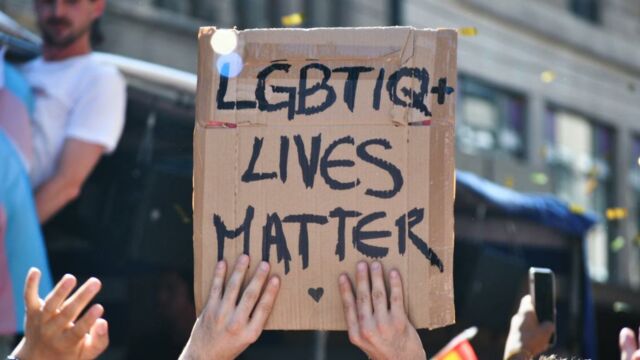What is asexuality?

Asexuality is a valid, albeit misunderstood, sexual identity that people have been coming to terms with for years.
In 1981, the feminist newspaper Heresies received an unexpected letter from a woman named Catherine Kobaly. In the letter, she asked:
Discover our latest podcast
Why, in 1981, are asexuals the only ones left in the closet?More under this adMore under this ad
She went on to describe her struggles with sexual identity and the shame that accompanies it, even though she and most of her close friends were asexuals. Kobaly called for the ‘othering’ of asexuals to stop, proposing that society attack the feelings of shame pushed onto people without sexual relationships. Once this is achieved, she said:
Then, I believe we will see that there are just as many asexuals in the world as heterosexuals and homosexuals, that our [asexual] lifestyle, while not our choice, is just as real and valid, and that we deserve a fair and equal representation.More under this adMore under this ad
What is the definition of asexual?
An asexual person (or 'ace') is someone who has little or no sexual attraction to others. Usually, asexual people avoid sexual contact, but like gender, asexuality is a spectrum, and this is not always true. The asexual spectrum has two orientations, romantic and sexual, and it’s a common misconception that asexual people cannot have sex or be in romantic relationships.
Asexuality can include people who have no romantic or sexual attraction at all, people who only develop romantic or sexual feelings until after establishing an emotional bond, or people who fluctuate between asexual or aromantic, and sexual or romantic.
More under this adMore under this ad
A brief history
Despite the belief that asexuality is a relatively new internet sensation that stemmed from Tumblr communities, the very first written acknowledgment of asexuality was in 1896 when German sexologist Magnus Hirschfield describes people without any sexual desire. Though there was no concrete terminology to describe this sexual orientation, plenty of people recognized the basics of asexuality from the beginning.
More under this adMore under this adIn the 1970s and 1980s, asexuality started to garner far more attention in the LGBTQ realm. Lisa Orlando’s The Asexual Manifesto was published by the New York Radical Feminists in 1972. David Bowie discusses asexuality in a Rolling Stone article in 1974. In 1981, Catherine Kobaly wonders why asexuals are burdened to remain unrepresented for so long.
The reason so many people assume asexuality was conceived on the Internet is that there wasn’t enough support behind asexuals until the 21st century. In 2001, the Asexual Visibility and Education Network (AVEN) was founded, which was one of the most well-known asexual communities at the time. Articles, research, and media started truly acknowledging the existence of asexual people.
More under this adMore under this adWhere are we now?
Fast forward to the past decade, and you’ll see that asexual representation is more commonplace nowadays. The asexual pride flag was first introduced to the public in 2010, along with Asexual Awareness Week. Dating platforms were launched that catered specifically to asexual and aromantic relationships, international conferences were being held in the name of asexuality, and people started to feel comfortable using the label 'asexual.' Mainstream representation of asexual people, while there’s still plenty of room to improve, is more widely accepted.
Instead of being forced to hide in the shadows, asexuality is slowly being understood and normalized. While there’s still plenty of work to be done and stigma to combat, it’s helpful to reflect on the progress made so far.
More under this adMore under this ad
Key figures
Asexuality might not have many major public figures in its history, but that’s not because of a lack of asexual people. In fact, it’s popularly theorized that Nikola Tesla, Isaac Newton, and even sex icon Marilyn Monroe were asexuals. In her diaries, Monroe often described herself as never having any desire for sex or kissing, describing herself as 'unsensual.'
More under this adMore under this adHowever, people like David Jay, who founded AVEN, certainly played prominent roles in creating supportive systems for asexual people all over the world. Sara Beth Brooks, who founded Asexual Awareness Week, helped encourage others to celebrate their sexuality instead of shy away from it.

How do I be an ally to asexual people?
- Stop telling asexual people they haven’t found the right person yet. When people come out as asexual, they’re often invalidated. Many asexual people are told 'oh, you’re just a late bloomer,' 'you’re too young to understand,' or 'you just don’t know what you’re missing.' Your experience with sex is not everyone else’s. Believe them and respect their sexuality!
- Research different ace identities. Since asexuality is an umbrella term, there’s still plenty more to learn when it comes to different identities along the spectrum. Read up on these different identities and understand that asexual people can have multiple identities without making them any less asexual.
Don’t interrogate people over their sex lives. People are often curious about things they don’t understand, but it is never acceptable to ask intrusive questions about someone’s sex life. It doesn’t matter if they’re sexual people or not.